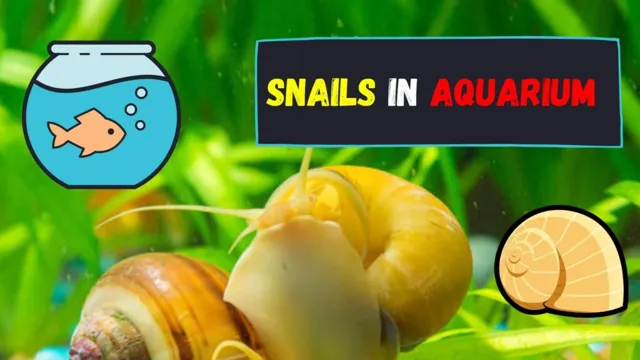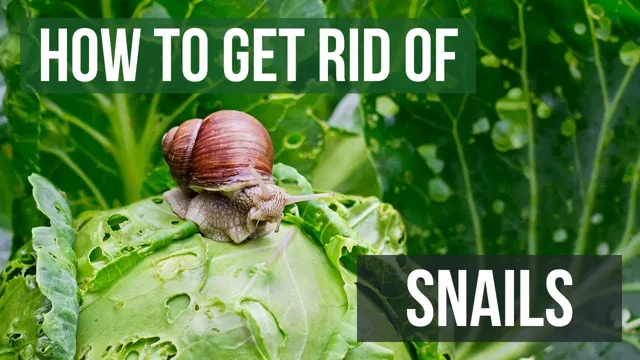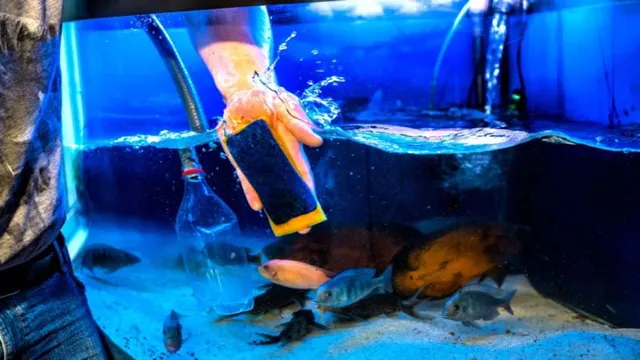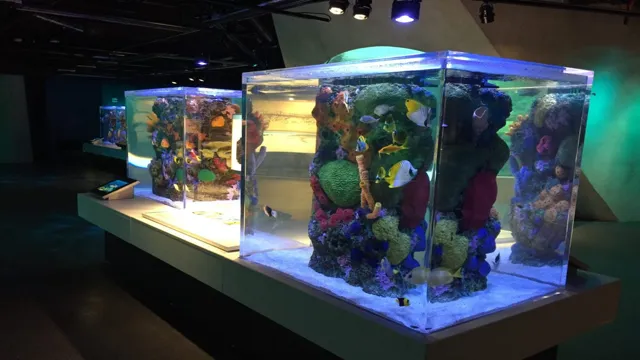How to Get Rid of Pond Snails in My Aquarium: Tips and Tricks

Are you wondering how to get rid of pesky pond snails in your aquarium? These tiny creatures may seem harmless, but they can quickly take over your tank and become a major nuisance. Not to mention, they can eat your aquarium plants and clog your filter, causing harm to your fish. But fear not, there are several effective methods to eliminate pond snails from your aquarium.
In this post, we’ll explore the different methods and offer tips on how to prevent them from returning so you can finally get your aquarium back to a healthy state. So, let’s dive in and learn how to bid farewell to those unwanted pond snails!
Identify the Type of Snails You Have
If you are struggling with pond snails invading your aquarium, the first step towards getting rid of them is to identify the type of snails you have in your tank. Different species of snails have varying behavior and can be treated with different methods. Some of the most common types of pond snails include Malaysian Trumpet Snails, Ramshorn Snails, and Bladder Snails.
Malaysian Trumpet Snails are known for burrowing into the substrate, while Ramshorn Snails have a distinct spiral-shaped shell, and Bladder Snails move around a lot and tend to attach their eggs to hard surfaces. Once you have identified the types of snails in your aquarium, you can research the best methods to control their population. One vital thing to keep in mind during the treatment process is not to harm any other aquatic creatures in your aquarium.
A crucial way to prevent future snail invasions is to avoid overfeeding your fish and regularly cleaning the tank. By taking these measures, you can beat those pesky pond snails and maintain a healthy aquarium.
Examine the Physical Characteristics of the Snails
Identifying the type of snails you have is an essential first step in taking care of them. There are numerous snail species, each with distinct physical characteristics. For instance, you can identify various snail species by their shells.
The shape and size of a snail’s shell depend on its type. Some might have a shell that spirals to the right, while others spiral to the left. Some may even have a dome-shaped shell, and others may have a flat shell.
Additionally, coloration can differentiate snail species. Some snails might have a uniform color on their shell, while others may have stripes or patterns. Apart from their shells, some snail species have differences in their tentacles, which are used for exploring their environment.
The coloration and length of a snail’s tentacles may also vary. By critically observing a snail’s physical characteristics, you can determine the type of snail you have and proceed to take appropriate care steps.

Consider the Source of the Snails
When it comes to dealing with snails in your garden or home, the first step is to identify the type of snail you have. There are various types of snails, with some being harmless and even beneficial to your plants, while others can cause damage and spread diseases. One way to identify them is by considering the source.
Are they wild snails that have migrated to your garden, or did you bring them in intentionally? If you bought them from a pet store or online, chances are they are not native snails and could potentially be harmful. Another way to identify them is by their physical characteristics. Do they have shells of varying shapes and sizes, or are they naked snails? Knowing the type of snail you have is crucial in determining the best course of action to take, whether it’s removing or controlling them.
By doing a bit of research, you can quickly determine the type of snail you have and take appropriate measures to protect your garden and home. (See Also: How to Add Aquarium Salt in Freshwater Tank to Treat Ich: A Step-by-Step Guide)
Prevent Further Infestations
Pond snails can quickly overrun an aquarium if left unchecked. There are a few different methods for getting rid of them, but it’s also important to take steps to prevent future infestations. One good way to do this is to keep your tank clean and well-maintained.
Regular water changes and trimmings can help prevent algae buildup, which is a prime feeding ground for pond snails. You may also want to consider introducing natural predators, such as loaches or assassin snails, to help keep snail populations in check. Finally, be cautious when introducing new plants or fish to your tank, as they may carry snail eggs or larvae that could lead to a new infestation.
By staying vigilant and taking proactive measures, you can keep your aquarium free of unwanted pond snails.
Maintain Proper Water Parameters
Maintaining proper water parameters in your aquarium is crucial to prevent further infestations. Every fish species has its own requirements when it comes to water quality, so it’s important to research and understand these needs in order to keep your aquatic animals healthy. Factors like pH, temperature, and hardness should be monitored and adjusted accordingly.
Additionally, regularly testing for ammonia and nitrate levels is vital to prevent harmful buildup that can harm aquatic life. By keeping your water parameters in check, you can create a healthy and thriving environment for your fish, while also preventing the growth of unwanted pests like algae and parasites. Don’t forget that maintaining water quality is an ongoing process, so regular attention and care are key factors in ensuring the long-term health of your aquarium.
Clean Your Aquarium Regularly
Regularly cleaning your aquarium is crucial not only for the health of your fish but also to prevent further infestations. Neglecting to clean your tank can lead to a build-up of harmful toxins, parasites, and bacteria, making it an ideal breeding ground for pests. Dust, debris, uneaten food, and fish waste can quickly accumulate, contributing to poor water quality and a higher risk of disease.
By maintaining a routine cleaning schedule, you can minimize the possibility of infestations and ensure that your fish live in a clean, healthy environment. A helpful tip is to remove any uneaten food and waste daily and perform a partial water change once a week. Making these small, consistent efforts can significantly improve the longevity and well-being of your fish.
So, do your fish a favor and give them a clean home to thrive in.
Quarantine New Plants and Fish
When introducing new plants or fish to your aquarium, it’s essential to quarantine them first to prevent further infestations. Even if they appear healthy, it’s not worth the risk of introducing harmful parasites or diseases to your established tank. Before introducing them to your main tank, set up a separate quarantine tank with similar water parameters as your main tank and let the new additions acclimate for a few weeks.
During this time, closely monitor them for any signs of illness or stress. It may seem like extra work, but taking the time to quarantine your new plants and fish can ultimately save you from a lot of headache and potentially devastating consequences. So, don’t skip this important step in maintaining your aquarium’s health and sustainability.
Eliminate Existing Pond Snails
If you’re dealing with pesky pond snails in your aquarium, there are a few different methods you can use to eliminate them. One of the easiest ways is to manually remove as many snails as possible. You can use a net or tweezers to pluck them out of the water, or you can bait them with a piece of fresh food and then remove them once they’ve gathered around it. (See Also: Is Aquarium of the Bay Worth It? Here’s What You Need to Know Before You Go)
Another option is to introduce natural predators into your aquarium, such as assassin snails or certain species of fish. However, be aware that this can disrupt the natural balance of your tank if you add too many predators. Finally, you can use chemical treatments designed specifically to eliminate pond snails.
Just be sure to follow the instructions carefully and monitor your tank closely after using any chemicals, as they can harm other aquatic life if used improperly. With a bit of patience and persistence, you can get rid of those pesky pond snails and keep your aquarium looking clean and healthy.
Use a Snail Trap
If you’re struggling with a snail infestation in your pond, using a snail trap can be an effective solution. These traps are designed to attract and capture snails, so you can remove them from the water and prevent them from multiplying. To use a snail trap, simply place it in your pond and wait for the snails to crawl inside.
You can find snail traps at most pet or garden supply stores, and they’re usually affordable and easy to use. The key to eliminating existing pond snails is to be patient and consistent with your trapping efforts. While it may take some time to see results, using a snail trap can be a humane and efficient way to reclaim your pond from these pesky critters.
With a little bit of patience and perseverance, you can restore balance to your pond and enjoy it once again.
Add Snail-Eating Fish to Your Aquarium
If you’re tired of seeing snails take over your aquarium or pond, consider adding snail-eating fish to your ecosystem. The addition of these fish can help eliminate existing snails by consuming their eggs and small larvae. One popular snail-eating fish is the assassin snail, which is known for its ability to take down large numbers of snails.
Another option is the clown loach, which is a colorful and entertaining fish that also loves to munch on snails. However, it’s important to note that adding snail-eating fish should be done carefully and with consideration for the other inhabitants of your aquarium or pond. Make sure to research the specific needs and temperaments of the fish before introducing them to your ecosystem.
With the right preparations, adding snail-eating fish can be an effective and natural way to control unwanted snail populations.
Conclusion and Final Tips
In conclusion, if you’re tired of your aquarium feeling like a snail spa, it’s time to take action. Firstly, avoid overfeeding your fish to prevent excess food from becoming a feast for the snails. Secondly, manually remove as many snails as possible.
Thirdly, introduce predatory fish or other organisms that can help naturally control the snail population. And finally, if all else fails, consider adding some humor to the situation – after all, a snail or two can make for an entertaining and quirky addition to your aquatic ecosystem. But if you’re determined to keep them out of sight, follow these tips and you’ll be on your way to a snail-free aquarium. (See Also: How to DIY 3D Concrete Aquarium Background – Step-by-Step Guide)
Happy fish-keeping!”
FAQs
What are pond snails?
Pond snails are aquatic gastropods commonly found in aquariums. They are usually regarded as pests because they breed quickly and can quickly overrun an aquarium.
How do pond snails get into an aquarium?
Pond snails can enter an aquarium through plants, fish, or aquarium equipment that has been in contact with them. They can also hitch a ride on new aquarium additions.
What are the problems of having pond snails in an aquarium?
Pond snails can cause issues in an aquarium such as overpopulation, damage to plants, clogging of filter intakes, and the release of excess waste.
What are some natural ways to get rid of pond snails?
One natural way to get rid of pond snails is to add snail-eating fish to your aquarium. You can also try manually removing the snails or reducing their food source.
Are there any chemical treatments for getting rid of pond snails?
Yes, there are chemical treatments available that can help eliminate pond snails. However, it is important to carefully follow instructions and dosages and be cautious of potential harm to other aquarium inhabitants.
How long does it take to get rid of pond snails?
The time it takes to get rid of pond snails will depend on the method used and the size of the infestation. It could take anywhere from a few days to several weeks to fully remove them from an aquarium.
How can I prevent pond snails from coming back into my aquarium?
To prevent pond snails from returning to your aquarium, make sure to quarantine new plants and fish before adding them, thoroughly clean all aquarium equipment, and avoid overfeeding your aquarium inhabitants.






